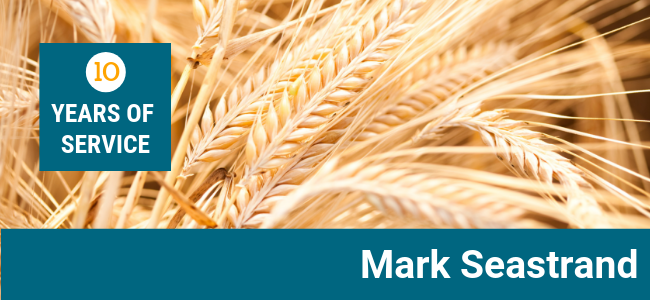Mark Seastrand has served as the barley sector director of the U.S. Grains Council (USGC) since his first USGC meeting 10 years ago, but he brought with him years of barley industry leadership when he joined the Council.
Seastrand has farmed in east-central North Dakota since he was 14 years old, raising small grains and oilseeds. Years ago, he headed to Minot to work an ag show as part of a part-time job with the state seed department. He and his boss joined the North Dakota barley crew for a dinner. Listening to a speaker sharing stories about the Council’s work, Seastrand remembered thinking, “This is something I want to get involved with.”
Years later, Seastrand had waited for the county representative position to be open, was elected by a unanimous ballot of two votes – himself and the county agent – and met that same speaker – Jim Broten, a past USGC chairman – at the election for a representative to the North Dakota Barley Council.
“I go over to this meeting and lo and behold, here is the guy who talked at that meeting in Minot,” Seastrand said.
At the meeting, the current representative, Richard Groven, announced he would like to serve one more term, and Seastrand offered to fill his slot once available, which he did four years later.
After joining the North Dakota Barley Council, Broten invited Seastrand to San Diego for the Council’s annual meeting. In the barley sector meeting, the current director announced he was running for the USGC officer team, and Seastrand was volunteered as his potential replacement.
“Long story, short, Don Fast became chairman, and I became the barley sector director,” Seastrand said. “Broten said, ‘You are now the sector director for the Council for barley, and we don’t take this lightly. I’m going to hold you to it.’ That was 10 years ago.
“I jumped in and I didn’t know much, but the USGC people were just spectacular. Everyone on the USGC Board of Directors at the time, they were people just like me that had the same ideas, the same goals, same background.”
The Council recognized Seastrand for those 10 years of service during the organization’s 16th International Marketing Conference and 59th Annual Membership Meeting earlier this year. He highlighted the importance of the Council’s work to develop specialized markets for U.S. barley production, such as food-grade barley as a specialty product in Asia.
“We don’t have that much production to work with, but what we do have are some loyal customers,” Seastrand said. “We have been working a lot of years in Taiwan, Japan and South Korea.”
According to Seastrand, working with customers overseas to not just sell a product, but establish a relationship, is a pillar of the Council’s work – no matter the commodity.
“A good part of our job is, more or less, shaking hands and developing relationships,” Seastrand said. “And that’s what I’ve learned having this job for the last 10 years – how to meet people, how to promote our own products – and that’s what we do, build relationships.”
About The U.S. Grains Council
The U.S. Grains Council develops export markets for U.S. barley, corn, sorghum and related products including distiller’s dried grains with solubles (DDGS) and ethanol. With full-time presence in 28 locations, the Council operates programs in more than 50 countries and the European Union. The Council believes exports are vital to global economic development and to U.S. agriculture’s profitability. Detailed information about the Council and its programs is online at www.grains.org.


